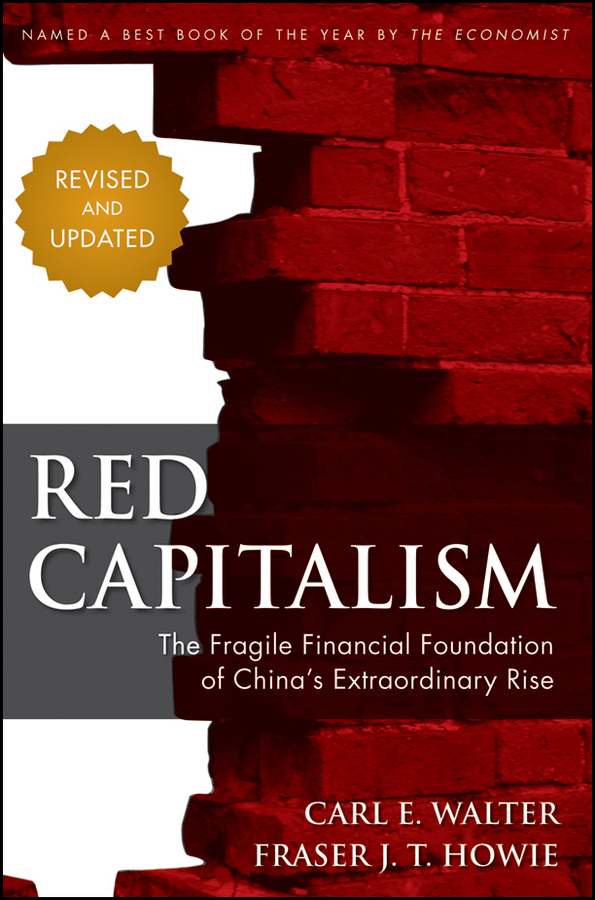Электронная книга: Carl Walter «Red Capitalism. The Fragile Financial Foundation of China's Extraordinary Rise»

|
The truth behind the rise of China and whether or not it will be able to maintain it How did China transform itself so quickly? In Red Capitalism: The Fragile Financial Foundation of China's Extraordinary Rise, Revised Edition Carl Walter and Fraser Howie go deep inside the Chinese financial machine to illuminate the social and political consequences of the unique business model that propelled China to economic powerhouse status, and question whether this rapid ascension really lives up to its reputation. All eyes are on China, but will it really surpass the U.S. as the world's premier global economy? Walter and Howie aren't so certain, and in this revised and updated edition of Red Capitalism they examine whether or not the 21st century really will belong to China. The specter of a powerful China is haunting the U.S. and other countries suffering from economic decline and this book explores China's next move Packed with new statistics and stories based on recent developments, this new edition updates the outlook on China's future with the most cutting-edge information available Find out how China financed its current position of strength and whether it will be able to maintain its astonishing momentum Indispensable reading for anyone looking to understand the limits that China's past development decisions have imposed on its brilliant future, Red Capitalism is an essential resource for anyone considering China's business strategies in today's extremely challenging global economy. Издательство: "John Wiley&Sons Limited (USD)"
ISBN: 9781118255117 электронная книга Купить за 1947.93 руб и скачать на Litres |
Carl Walter
Carl Walter (* 29. August 1834 in Wimpfen; † 24. April 1906 in Stuttgart) war ein deutscher Architekt und Lehrer bzw. Direktor der Baugewerkschule Stuttgart.
Inhaltsverzeichnis |
Leben
Carl Walter studierte zunächst an der Höheren Gewerbeschule Darmstadt, dann war er von 1856 bis 1861 Student bei Friedrich August Stüler und Eduard Knoblauch an der Berliner Bauakademie.
Seit 1861 lebte er in Stuttgart und arbeitete dort als Architekt. 1864/1865 war er Mitglied des Bürgerausschusses und von 1865 bis 1871 des Gemeinderates der Stadt Stuttgart. Seit 1865 war er Lehrer für Architekturfächer an der Königlich Württembergischen Baugewerkschule Stuttgart. 1869 wurde er zum Professor ernannt. Seit 1896 war er als Nachfolger von Joseph von Egle Direktor der Baugewerkschule. 1905 wurde er Vorsitzender des Württembergischen Vereins für Baukunde.
Neben seiner Lehrtätigkeit errichtete er zahlreiche Villen und öffentliche Bauten in und um Stuttgart.
Sein Sohn Rudolf Walter war Architekt und Baubeamter in Berlin-Charlottenburg.
Bauten
Stuttgart
- Villa Luise Siegle, Reinsburgstraße 56 (1865/66)
- Doppelmietshaus, Reinsburgstraße 28/30 (1866)
- Haus Schnabel, Silberburgstraße 172 (1867)
- Doppelmietshaus (mit Carl Eitelbuß), Werastraße 6/8 (1870/71)
- Mittelschule für Knaben und Mädchen (mit Heinrich Wagner), Kasernenstraße 24-26 (1872-74)
- Villa Clason, Wagenburgstraße 13 (1873/74)
- Haus der Museumsgesellschaft (mit Heinrich Wagner), Lindenstraße 10 / Rotestraße (1873-76)
- Villa Jäger und Binder, Marienstraße 33 (1874/75)
- Wohnhaus Knosp, Feuerseeplatz / Rotebühlstraße (1881-83)
- Villa Sieber, Mörikestraße 21 (1894/95)
Ludwigsburg
- Villa Franck, Leonberger Straße 8 (1887-89)
Tübingen
- Villa Lust (Ludwigslust), Neckarhalde 56 (1888)
Ulm
- Saalbau, Bahnhofstraße / Mühlengasse (1894-96)
Literatur
- Christine Breig: Der Villen- und Landhausbau in Stuttgart 1830–1930. (= Veröffentlichungen des Archivs der Stadt Stuttgart, Band 84.) Hohenheim Verlag, Stuttgart und Leipzig 2000, ISBN 3-89850-964-8, S. 541.
Weblink
- Ludwigslust - Ein vergessener Garten in der Tübinger Neckarhalde. Unter dem Abschnitt „Das Wohnhaus“ ist eine Kurzbiographie eingepflegt.
- Deutscher Architekt
- Architekt (Stuttgart)
- Person (Württemberg)
- Geboren 1834
- Gestorben 1906
- Mann
Источник: Carl Walter
Другие книги схожей тематики:
| Автор | Книга | Описание | Год | Цена | Тип книги |
|---|---|---|---|---|---|
| Carl Walter | Red Capitalism. The Fragile Financial Foundation of China's Extraordinary Rise | The truth behind the rise of China and whether or not it will be able to maintain it How did China transform itself so quickly? In Red Capitalism: The Fragile Financial Foundation of China's… — John Wiley&Sons Limited (USD), электронная книга Подробнее... | 1947.93 | электронная книга |
См. также в других словарях:
china — /chuy neuh/, n. 1. a translucent ceramic material, biscuit fired at a high temperature, its glaze fired at a low temperature. 2. any porcelain ware. 3. plates, cups, saucers, etc., collectively. 4. figurines made of porcelain or ceramic material … Universalium
China — /chuy neuh/, n. 1. People s Republic of, a country in E Asia. 1,221,591,778; 3,691,502 sq. mi. (9,560,990 sq. km). Cap.: Beijing. 2. Republic of. Also called Nationalist China. a republic consisting mainly of the island of Taiwan off the SE coast … Universalium
Late-2000s financial crisis — The TED spread (in red) increased significantly during the financial crisis, reflecting an increase in perceived credit risk … Wikipedia
literature — /lit euhr euh cheuhr, choor , li treuh /, n. 1. writings in which expression and form, in connection with ideas of permanent and universal interest, are characteristic or essential features, as poetry, novels, history, biography, and essays. 2.… … Universalium
international relations — a branch of political science dealing with the relations between nations. [1970 75] * * * Study of the relations of states with each other and with international organizations and certain subnational entities (e.g., bureaucracies and political… … Universalium
United States — a republic in the N Western Hemisphere comprising 48 conterminous states, the District of Columbia, and Alaska in North America, and Hawaii in the N Pacific. 267,954,767; conterminous United States, 3,022,387 sq. mi. (7,827,982 sq. km); with… … Universalium
